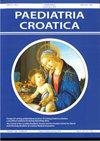Early diagnosis of neuronal ceroid lipofuscinosis type 2 – a myth or reality?
Q4 Medicine
引用次数: 0
Abstract
Neuronal ceroid lipofuscinosis type 2 (CLN2) is the most common childhood progressive neurodegenerative disease. The main features of CLN2 disease are language delay that precedes epileptic seizures, motor disorders, progressive deterioration of vision and cognition with death in early adolescence. The average time from the onset of fi rst symptoms to diagnosis is about two years. Delay in diagnosis postpones therapeutic approach involving multidisciplinary health care and effi cacious enzyme replacement therapy with cerliponase alpha (Brineura®). The availability of enzyme replacement therapy classifi es CLN2 disease in the group of treatable neurodegenerative diseases. Recognition of early symptoms is crucial to direct clinicians to appropriate examinations or seek additional expert opinion. Timely diagnosis is imperative because it allows treatment at an early stage of the disease. In all children with the fi rst unprovoked epileptic seizures between the ages of two and four, and particularly in those children with a history of language delay and motor impairment, the fi rst step is to measure the TTP1 enzyme activity by dried blood spot testing, which is available in our setting. Genetic testing and a fi nding of pathogenic mutations in the CLN2 gene confi rm the diagnosis. Raising awareness of CLN2 disease as a treatable and potentially curable disease and following the proposed guidelines will certainly contribute to early diagnosis of CLN2 disease to become our reality rather than a myth. Timely and accurate diagnosis is the fi rst step in improving the overall care of children with CLN2 disease and their parents.2型神经性脑蜡样脂褐质病的早期诊断是神话还是现实?
2型神经性蜡样脂肪褐变病(CLN2)是儿童最常见的进行性神经退行性疾病。CLN2疾病的主要特征是先于癫痫发作的语言迟缓、运动障碍、视力和认知的进行性恶化,并在青春期早期死亡。从首次出现症状到诊断的平均时间约为两年。诊断的延迟推迟了涉及多学科卫生保健和有效的cerliponase - α (Brineura®)酶替代治疗的治疗方法。酶替代疗法的有效性将CLN2疾病分类为可治疗的神经退行性疾病组。识别早期症状对于指导临床医生进行适当的检查或寻求额外的专家意见至关重要。及时诊断是必要的,因为它可以在疾病的早期阶段进行治疗。对于所有在2岁到4岁之间首次无端癫痫发作的儿童,特别是那些有语言迟缓和运动障碍史的儿童,第一步是通过干血斑点测试来测量TTP1酶的活性,这在我们的环境中是可用的。基因检测和CLN2基因致病性突变的发现证实了诊断。提高对CLN2疾病作为一种可治疗和潜在可治愈疾病的认识,并遵循所提出的指南,必将有助于CLN2疾病的早期诊断成为现实,而不是神话。及时准确的诊断是改善CLN2患儿及其家长整体护理的第一步。
本文章由计算机程序翻译,如有差异,请以英文原文为准。
求助全文
约1分钟内获得全文
求助全文
来源期刊

Paediatria Croatica
医学-小儿科
CiteScore
0.20
自引率
0.00%
发文量
0
审稿时长
6-12 weeks
期刊介绍:
In the inaugural 1956 issue of the journal, the editor Dr Feđa Fischer Sartorius outlined the journal''s vision and objectives saying that the journal will publish original papers on the development, pathology, and health care of children from the prenatal period to their final biological, emotional and social maturity. The journal continues this vision by publishing original research articles, clinical and laboratory observations, case reports and reviews of medical progress in pediatrics and child health.
 求助内容:
求助内容: 应助结果提醒方式:
应助结果提醒方式:


